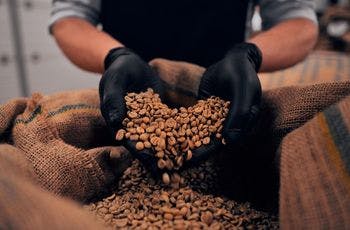
Single Origin Coffee vs Coffee Blends (Know The Difference)

If you are a coffee lover then you must have come across a situation where you stood confused at a shop staring and wondering which beans to choose. You're not alone! Even I used to get confused when I was a novice.
Choosing between single-origin and blend is a challenging task. It's like picking between siblings: both bring joy but in different ways.
Today in this blog I will share with you everything about single-origin coffee and coffee blends and help you discover your perfect match. So without waiting anymore, let's dive in.
What is single-origin coffee?
Think of it as a solo singer: just one voice, one place, one flavor. It's all about one special bean, grown in a specific region like Ethiopia or Sumatra, offering you a taste of that unique terroir.
Imagine sipping Ethiopian Yirgacheffe with its bright citrus notes, or diving into the chocolatey depths of Sumatran Mandheling. When we consider single-origin coffee it's all about the purity and uniqueness of coffee beans that come from a singular geographic location.
Advantages of single-origin coffee
1) Distinctive flavor profiles
Single-origin is all about the star bean that you choose. You get to savor a bean's unique character, with every sip presenting the detailed notes of its terroir. Imagine Ethiopia's bright citrus, Sumatra's deep chocolate, or Kenya's juicy berries – it's an outburst of flavors indeed.
2) Uniqueness
No blending or masking is performed with single-origin coffee. Just beans with their quirks and personalities. Some can be fruity, others earthy and bold – but all are authentic and captivating. It's coffee with a backstory holding a taste of a distinct farm, and its dedication to quality.
3) Sustainability
Single-origin coffees usually follow the natural harvest seasons of their specific regions. It not only supports sustainability but also introduces coffee enthusiasts to a dynamic range of flavors that evolve as per the changing seasons.
4) Supports local farmers
Choosing single-origin coffee often means supporting local farmers and their communities. This ethical dimension adds a feel-good factor to your coffee ritual, knowing that your preference contributes to the sustainability of small-scale coffee producers.
Disadvantages of single-origin coffee
1) Availability issues
Single-origin coffees are often seasonal and depend on specific harvest seasons. Thus their availability fluctuates. So it can be a considerable challenge for those who seek consistency or have a particular origin preference.
2) High price point
As single-origin coffee is unique and seasonal it tends to be priced higher than blends. Thus it is a considerable point for budget-conscious coffee enthusiasts, especially if the distinctive flavors don't align with their personal preferences.
3) Intensity might not suit everyone
The bold and distinct flavors of single-origin coffee may not appeal to every individual. Some coffee drinkers prefer the balanced and blended characteristics found in different coffees.
4) Dependency on harvest quality
The quality of a single-origin coffee depends largely on the specific harvest conditions of that region. Variations in weather or other factors can affect the taste, and a suboptimal harvest might result in less flavorful beans.
What is a coffee blend?
Well, coffee blends are like the ultimate mashup, a perfect blend of beans, each contributing unique flavor notes to create a flavorful and balanced cup. Think of it like your favorite playlist: different songs, and different notes, but together they hold a magical mood-boosting ability.
It's all about combining complementary flavors. Picture the bright acidity of Kenyan beans blending with the chocolatey richness of Colombia, or the floral notes of Ethiopian Yirgacheffe balancing the nutty warmth of Guatemalan Antigua.
Advantages of coffee blends
1) Balanced flavors
Blends provide a balanced flavor profile by combining beans with different taste profiles. This artful blending results in a cup that's neither too bold nor too mild, appealing to a broad spectrum of palates.
2) Consistency across seasons
One significant advantage of coffee blends lies in their capability to maintain a consistent taste profile year-round. By blending beans from various regions, roasters can avoid the impact of seasonal variations, ensuring a reliable and familiar flavor.
3) Versatility
Roasters experiment with various roasting levels when working with blends. This versatility allows them to craft coffees with subtle flavors, from light and bright to dark and robust, catering to a diverse audience.
4) Customization preferences
Blends present the chance for roasters to tailor their drink to specific preferences. Whether someone enjoys a hint of acidity, a full-bodied richness, or a subtle sweetness, there's a blend prepared to satisfy every taste preference.
5) Aromatic blend
The combination of different beans in a blend often results in an aromatic intricacy that tantalizes the taste buds. From the moment you grind the beans to the final pour, the fragrance of a well-blended coffee is an integral part of the experience.
6) Economical and accessible
Blends are a more economical option, making them accessible to a wider audience. With the ability to use beans from different sources, roasters offer quality blends at a more budget-friendly price point.
Disadvantages of coffee blends
1) Original flavors masked
The blending overshadows the individual characteristics of each bean. Thus for those who appreciate the unique flavors of specific regions, blends might lack the terroir-specific nuances found in single-origin coffees.
2) Dependency on roaster expertise
The success of a coffee blend often is subjective as per the expertise of the roaster. If the blending process is not executed well, the result could be an imbalanced cup. Thus dependency on the roaster's skill is a potential drawback.
3) Impact of price fluctuations
The composition of coffee blends often involves beans from different regions, and market fluctuations might influence the cost of these beans which can result in price variations for blends, potentially affecting the consumers with budget constraints.
4) Challenging for new roasters
Crafting a well-balanced blend requires expertise that might be challenging for new roasters. Acquiring the right combination of beans to create a balanced flavor is a skill that can be developed over time.
5) Potential for over-roasting
During roasting, some roasters might mistakenly over-roast the beans in a blend. It can lead to a loss of nuance and might make beans taste charred or burnt, which is not suitable for coffee lovers who prefer lighter roasts.
Single-origin vs coffee blends: Quick comparison
1) Flavor profile
Single-origin beans are bold and unique and highlight specific terroir and bean characteristics. On the other hand, coffee blends are balanced, and consistent, combining complementary flavors for a balanced taste.
2) Seasonality issues
Single-origin beans align with the natural growing seasons of specific regions so they are seasonal. While coffee blends are crafted to minimize the impact of seasonal variations, providing a more consistent flavor profile year-round.
3) Price
Single-origin beans are generally more expensive due to limited availability and specialized processing. On the other hand, blends are often more affordable due to easy availability and blending.
4) Availability
Single Origin beans are seasonal and depend on crop variations. At the same time, blends are more consistent and available easily due to the combination of different beans.
5) Brewing method
Single-origin beans might require specific brewing methods and parameters to spotlight their unique characteristics. While blends are good to go with any brewing methods.
Coffee blends or single-origin coffee: Which should you choose?
The choice between a blend and a single origin depends on one’s preference. But If you adore authentic regional nuances and a single-flavor journey, single-origin beans are recommended, while if a balanced and consistent taste year long is your priority then choose coffee blends.
Moreover if budget is a constraint for you then go for coffee blends while if your main focus is a distinct profile pick single-origin beans.
Wrapping up
That's a wrap for this blog. I hope by now you have complete information about both single-origin and coffee blends. Now note down your requirements, explore different beans, and choose your perfect fit.
Also, don’t forget to share your views in the comments below. For more such coffee adventures, subscribe to our YouTube channel or follow us on Instagram to join our vibrant, growing community.
FAQs
1) Why is single-origin coffee so expensive?
Single-origin coffees are more expensive due to their limited production, unique terroir, and careful cultivation, resulting in a premium, exclusive experience.
2) Can you drink single-origin coffee with milk?
Yes, you can definitely add some milk but it's recommended to enjoy the pure flavors first; adding milk may overshadow the distinct characteristics of single-origin coffee.
3) Which origin is best for coffee?
The "best" origin varies based on preferences. Ethiopian coffees are celebrated for their bright acidity, while Colombian coffees offer a well-balanced profile, catering to diverse tastes.

I am a barista by profession hailing from NC. My journey began in my late teens when I started working as a barista in a local coffee shop. My passion for coffee quickly became evident as I immersed myself in the art of espresso extraction, latte art ...



